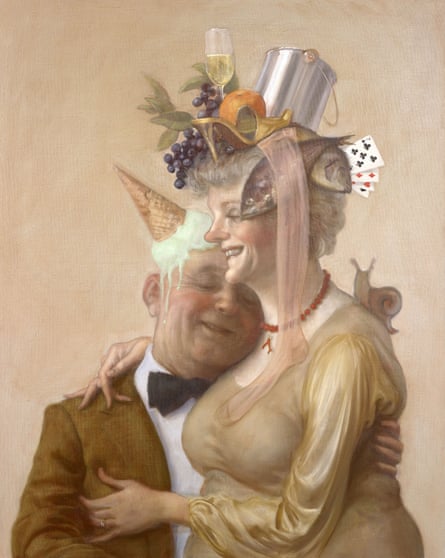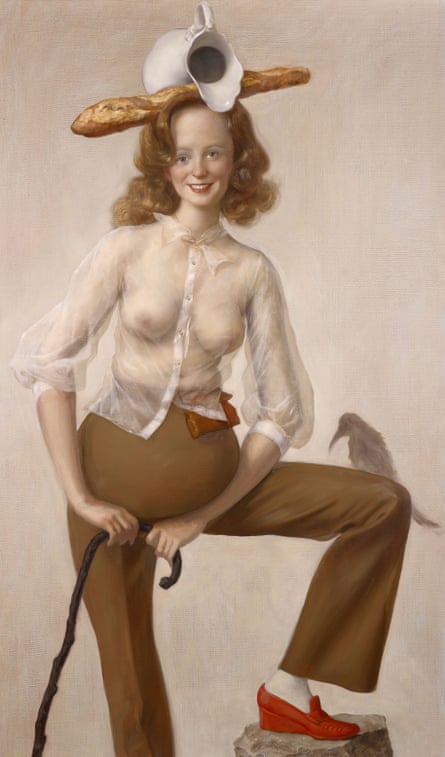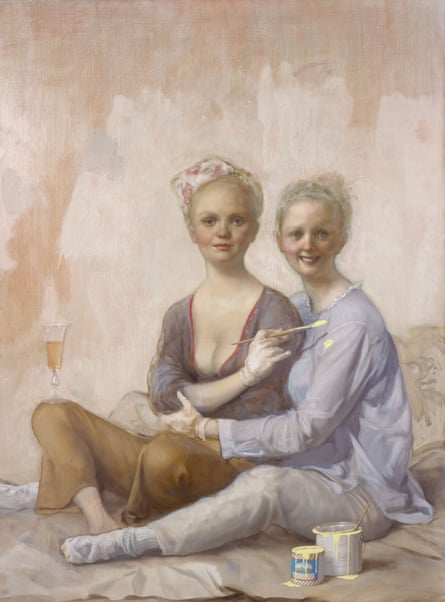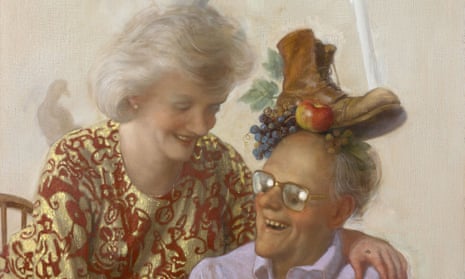A couple share a moment of domestic complicity, smiling over something the man is reading in a newspaper. It can’t be today’s paper, or they’d both be screaming. Inexplicably, a white china jug is perched on the woman’s greying hairdo. It is a lovely jug, perfectly rendered, perhaps placed there by a poltergeist. Hang on. Hubby also has a bunch of grapes, an apple and an old boot on his balding pate, but hasn’t yet noticed, and never will. Something weird is going on among the reflections behind the lenses of his spectacles. A fly rests on the woman’s hand, draped over the man’s shoulder. Is the painting meant as a sort of essay on mortality? The idea is easier to brush off than the fly itself.
The same white jug also reappears on top of another woman’s head in another painting. It is balanced there, offering us its dark and empty interior, by a fresh baguette. This, I think, is a reference to a Picasso still life. But this mad millinery, with its phallic and vaginal forms, is nothing to the woman herself, whose fresh-faced smile is belied by her out-of-kilter eyes, her discombobulated countenance. The more you look, the more skewed and out of proportion she is. Maybe that’s why she needs a walking stick. Is her belly distended by pregnancy? Could it be wind, or dropsy? A bird perches on her knee. Or it would if it weren’t so ghostly. I don’t like the look of its beak. I think it flew in from some medieval phantasmagoria and settled there.

There many things askew with the five paintings in John Currin’s show at Sadie Coles. Another ageing couple tenderly embrace. An upturned ice-cream cone is planted on the side of the man’s head, dribbling pistachio-coloured drool down his cheek. He leans into his partner’s shoulder. Her hand grasps his man-boob through his jacket and shirt. A ridiculous still life: Chardinesque playing cards, a glass of white wine, an orange, a shiny metal paint-can, a pair of fish (black bream, I surmise) and a high-heeled slipper teeters on her head, a draped silk stocking completing the impossible Dutch still-life ensemble. A snail climbs the woman’s back. It does not belong in this painting, but then what does?

Filled with visual jokes, art historical pastiche and unlovable people, Currin’s paintings are hard to take seriously – in fact, hard to take at all, and certainly not at surface value, although surface is all they are. As absurd and decadent as their high prices, and the art world in which they circulate, Currin’s canvases stop you in your tracks. He knows that paintings are a kind of high-end luxury object, conversation pieces and vanities for their owners. He knows we know it too. Like his contemporary Lisa Yuskavage (they studied together at Yale in the mid-80s), whose lurid, sickly paintings depict hippies, impossibly pneumatic fairy chicks and gross dudes, Currin paints pictures that defy taste. They have a painterly erudition that trips you up and makes you feel bad about both hating their work and liking it a lot. Both positions feel untenable. But then painting is untenable too, which is a good enough reason to be doing it.
Currin runs the full gamut of painterly effects, degrees of completion and different registers of paintedness, from trompe-l’oeil realism to the cartoonish, from high finish to cursory knocked-in grisaille and underpainting, from high-finish virtuosity to fuzzy, 18th-century rococo frivolity. Currin is extremely good at being excessively bad. There are jokes about genres and manners, and jokes about paint itself, jokes that mostly only other painters will get.
The wall to the rear of the Happy House Painters looks like scuffed-up old plaster, ready for a slap of emulsion and a sensitive sort of close-valued abstraction. I think of the space in Goya’s enigmatic Dog painting, with all its ghostly pentimenti. In the foreground of Currin’s picture, paint dribbles down a can of yellow household paint. The dribble isn’t just a dribble, but a painted dribble. There is a splotch of paint on the brush held by one of the two female decorators taking a breather. A smear of that yellow has got on to the second woman’s blue shirt. The yellow blob is both a real splotch of colour and a depiction of itself. It stays where Currin put it, on the surface of his painting and in its rightful place on the shirt, in the fictive painted space. This is very hard to get right. Currin nails it.

Things happen to the people in Currin’s paintings and things happen in the paint. He paints people and scenes that are really hard to take. Misanthropic, misogynistic, cruel, absurd, silly – all these criticisms could be – and have been – thrown at him. His art is about flesh, manners, types, relationships and, most of all, the question of representation. Isn’t that always the big question for painters, the what and how and why to paint? This group of new paintings is more than a laugh, a recoil and a grimace – though it is all these things. Once you get over the initial knowing wince, there is an awful lot to unravel. I don’t think I could live with a Currin; I certainly wouldn’t want to live inside one. But perhaps I already do.
- At Sadie Coles, London, until 21 January.

Comments (…)
Sign in or create your Guardian account to join the discussion